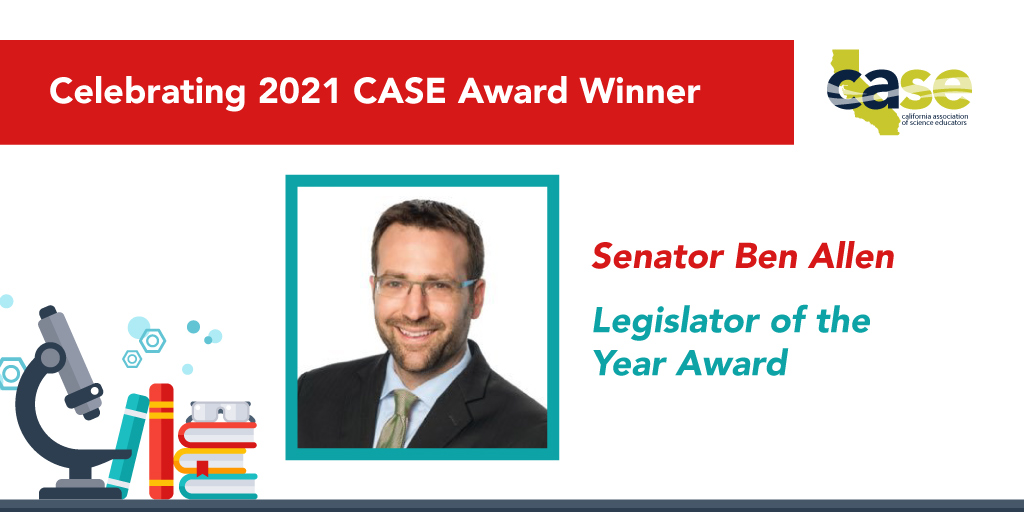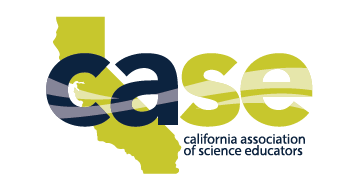
Legislator Award: Senator Ben Allen
- Awards Program Nominations
- 2024 Awards Winners
- 2023 Award Winners
- 2022 Award Winners
- 2021 Awards Recognition
- Future Science Teacher Award: Lili Gallegos
- Jessica Sawko Teacher Leadership Award: Philip Hudec
- Margaret Nicholson Distinguished Service Award: Laura Henriques
- Administrator Leadership Award: Sharon Matsuzaki
- Legislator Award: Senator Ben Allen
- Distinguished Contribution Award: Exploratorium
- Distinguished Contribution Award: Yuba Water Agency
- 2020 Awards Recognition
Senator Ben Allen

You recently worked on a successful bill which was signed into a law by Governor Newsom, securing $6M for the purpose of creating free educational resources on climate change and environmental justice for grades K-12 (AB/SB30). What long-term impact do you think/hope this will have for science education throughout the state?
I’m hopeful this initiative will be an important tool for educators teaching future generations about how our environmental choices have shaped our past and will shape our future. Students are following developments on climate change, environmental justice, clean air, and water. This curriculum will empower California’s students and teachers to explore locally-relevant solutions to pressing global issues, increase awareness and critical thinking, and inspire future environmental leaders.
What do you hope to accomplish with your efforts in the next 5 years?
Here in California, we’ve set ambitious climate goals and so far we’ve been able to reach those goals while growing our economy – proving that a greener economy can make for a stronger economy. Yes – reducing greenhouse gas emissions is an essential goal. But simply reducing emissions is not enough. We must be cognizant of the need to demonstrate to the world that sound climate policy makes smart economic sense. Success in California is moot if we can’t export our policies and encourage other states and nations to follow our lead. I’m deeply involved in efforts to lower plastic waste and transition packaging away from non-recyclable single-use plastics toward more sustainable alternatives. And I continue to be focused on good government initiatives, clean money, campaign finance reform, etc. One of the reasons why we struggle to make progress on environmental protections is because of the ever-growing influence of special interest money in the political process.
How did you initially find your passion for environmental advocacy and climate change education?
As a kid, I would spend weekends hiking with my dad in the Santa Monica Mountains or going down to the beach for a swim. My father instilled in me a deep love and respect for nature and the outdoors and the importance of fighting to protect our environment. My Boy Scout troop did the same, and my Eagle Scout project focused on envronmental education—teaching fellow high school students about the importance of properly disposing of changed motor oil. I had a fantastic science teacher at Santa Monica High School, Ingo Gaida, who not only taught me the ins and outs of AP Biology but also of environmental science. He was our club advisor for our high school Ecology Club. Of course, as I’ve gotten a greater understanding of what an existential threat climate change poses, I’ve become increasingly passionate about ensuring that the next generation of young Californians understands the threat and is committed to trying to fix the problem.
What advice do you have for science educators who wish to see changes in their local community or statewide, but are unsure of where to start?
First and foremost, science educators are already taking the most important action they can to support sound environmental policy -- and that is teaching our students! You are empowering younger generations with the foundation of knowledge and critical thinking skills they will so desperately need to combat and adapt to the climate crisis. I am a firm believer of the idea that people need to think globally and act locally—make personal behavioral changes that will help our environment and encourage others to do the same. And then engage local and state elected officials and their staff—talk to them about your concerns, offer your help, encourage them to enact science-based policies. Most elected officials and their teams want to make their communities better and are open to suggestions and help. Government is often a lot more accessible than people think. Reach out and engage!
What significance does this award hold to you?
I am honored to receive CASE’s Legislator of the Year award. Both as a student and then as a school board member, I experienced firsthand the impact our science educators have in shaping our students’ passions for environmental stewardship and community service. To be recognized for my team’s work for environmental protections and environmental education by the environmental educators themselves is a bit of a thrill.
Quick Links
Exhibit Partner Package
Opening Soon
Join us at the 2025 California Science Education Conference, the premier event for science educators across California! This gathering is your chance to showcase your products, engage with educators, and maximize your impact through our exclusive Partner Program.

